Welcome to the fleet!
Hej, min vänner! (Hello, my friends)
A number of you have been demanding photos of my floating abode and the mighty Vasa. I am only too pleased to oblige. I’ve already gone through two sets of camera batteries so I think I can find something to show you. It is a good stormy day to assemble photos for you to see. The wind came in last night, howling across the harbor and screaming in Sankt Erik’s rigging. Snow flurries obscured the city lights, the harbor began to ice over, and so I retreated aboard for a little shelter and warmth. At times it blew so hard that I felt the mighty Sankt Erik heaving slightly to leeward under the belligerent gusts, the wardroom lanterns swinging gently with the motion. Down in my cabin I discovered a new sound, that of wind whistling up the drainpipe into my sink causing a nasty, cold, geyser of a draught out of the sink. Apparently the through-hull is well above the waterline. I put in the drain plug and stuffed the overflow drain with a handkerchief to keep out the cold. Then, with a hot cup of tea from the galley, I settled in to prepare what you are about to see. Where shall we begin this time? ……….Well, I suppose now that I am already writing about my floating home, Sankt Erik, I ought to continue from there.

Welcome to the Sankt Erik, the plucky little Swedish icebreaker that kept the hundreds of miles of approaches to Stockholm harbor open during more than 60 winters between 1915 and 1977. She is a fine ship measuring roughly 180ft long, 58ft wide and some 5 (enclosed) decks high. Being located in the center of the city, she is therefore the best apartment in Stockholm.

“Safety First!”
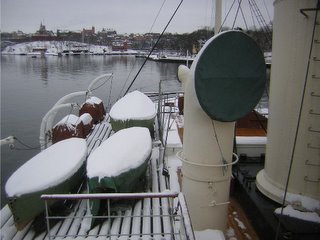
When I arrived, Stockholm had just completed nearly two weeks of snowfall, blanketing the entire ship in a lovely layer of fresh snow.
 An enclosed pilothouse was not built on the bridge until the 1950s. For 40 years her officers handled the ship in the open air, exposed to the piercing winds that blew across the frozen border regions of the Baltic.
An enclosed pilothouse was not built on the bridge until the 1950s. For 40 years her officers handled the ship in the open air, exposed to the piercing winds that blew across the frozen border regions of the Baltic.
Two decks below and almost directly beneath the bridge is my cabin, starboard side, just forward of amidships. It has a small desk, a narrow bunk, a sink, a small bureau, and a lone porthole. Note that I always keep a photo of the Wawona in view.
The Swedes are a tall people and therefore they build their ships with longer bunks than those found on most other ships and for that I am most thankful.
When I open the door to my cabin (the super-bright room on the left) I step out into this large room amidships. Given its size it would be easy to get thrown about in there in rough weather…but I suppose the seas stay pretty calm when they are frozen solid. The coup de grace of this compartment is the ship’s “grand staircase” on the right (aft side of the room) which goes up to the main deck and the ever-so-important galley where I stockpile my food. The ‘grand staircase’ and all Sankt Erik’s brass-work really gives her a noble feel, as if she were a great liner like Lusitania or Titanic…well, my ‘grand staircase’ isn’t that ornate…
The fact that I bothered to photograph this will tell you how pleased I am with the ship’s traditional lighting. There is no attempt to make her feel like a hotel. Sankt Erik is a ship and proud of it. It brings out the rivet-heads well too.
Across that large room with the ‘grand staircase’ on the ships port side is the head….bathroom for you lubbers. It has a shower too, but as you can see, the bare steel hull that forms one side of the room is an enormous heat-sink, giving away any warmth granted by the radiator to the frigid waters of the harbor.
Leaving the head and winding up the ‘grand staircase’ one finds the wardroom. This is the luxury space for the officers to dine and to entertain guests, a practice that the museum still continues in this space come summer. In the interim, it has become my study—a place to read and listen to music and soak in the atmosphere of the rich woodwork.
I know this place is nice, but shall we continue the tour?
Going aft from the wardroom on the main deck level you pass through this narrow corridor past the boiler room (right bulkhead) to the galley. Don’t worry, the passage is quite ‘homey’ with counters and portholes all the way down the left side (starboard side—‘left’ because we are going aft).
In the galley we find the massive coal-fired stove, a sink, and all the restoration crews’ vital coffee gear. Can you tell me what is wrong with this photo?
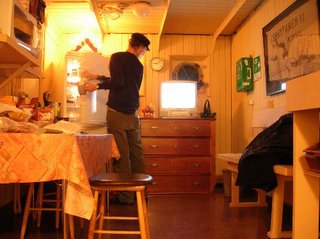 Aft of the galley is the restoration crews’ dayroom where live-aboards like me are also welcome to hang out. This is also where the only working refrigerator onboard is located. Likewise, it also contains the ship’s only TV, a device that is becoming essential to my study of the Swedish language…so far through cartoons.
Aft of the galley is the restoration crews’ dayroom where live-aboards like me are also welcome to hang out. This is also where the only working refrigerator onboard is located. Likewise, it also contains the ship’s only TV, a device that is becoming essential to my study of the Swedish language…so far through cartoons.
In the dayroom hangs this pennant made from a scrap of canvas commemorating Sankt Erik’s—a.k.a Isbrytaren II (Icebreaker II) —working days in 1915 when she led convoys through the ice to and from Stockholm.
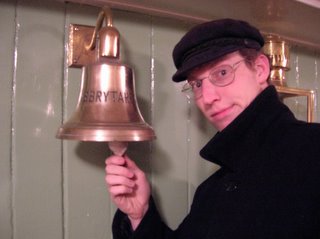
Well, enough of the crew spaces—although, there is much more back aft. Sankt Erik is a ‘living’ ship and thus we need to visit her steel and iron innards, see where her heart is, where the real soul of the ship lies…..the engine room.

The main engine, standing nearly three stories tall, is a sight to be had. Her four cylinders—each larger than the previous as she has a triple-expansion steam engine—are impressive to say the least. The low-pressure cylinder is nearly six feet in diameter. Compare that to a Honda. Then again, compare Sankt Erik’s 2,800 shaft horsepower to a Honda.

Taking to the maze of steel ladders and deck gratings, let’s descend two decks to the chief engineer’s level where the monstrous engine’s control levers and valves are located. Just grasping one of the brass handles, you can imagine the searing heat, the persistent hissing, and the gentle throbbing of the big engine….

…or hear the ring of the telegraph bell as an order comes down from the bridge demanding “Full Ahead” (or rather, “Full Framåt”) to drive against the ice…

And if this ship’s engines were not working pieces of equipment, I would be most tempted to ease open the throttle valve and imagine the pressure gauges jumping to attention.

The engine needs to be fed her steam from somewhere, so taking hold of a flashlight, we wriggle through a small hatch into the boiler room. It is icy cold today, but in her operating days the temperature in here would have been well over 100º F. The sheer size of these boilers indicates how much power this icebreaker had. Above, you can only see one-third of the No. 2 boiler. There are 3 other boilers in this space, each of massive proportions. So this entire photo really only shows one-twelfth of Sankt Erik’s boiler capacity.

Crawling further forward through the innards of the Sankt Erik, we reach the forward engine room. This comparatively smaller engine (1200shp) drives a propeller under the bow that is used to flush the broken ice aft along the hull as the ship creeps ahead. Just in case you are starting to feel at all claustrophobic, I suppose we ought to return to the deck.
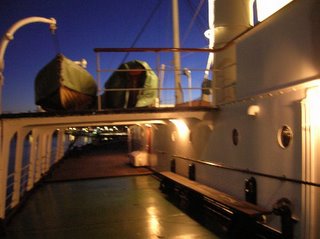 Being nearly 60 feet wide (= to 1/3rd of her length), Sankt Erik has an enormous amount of deck space that, I am told, lends itself very well to summer barbeques and harbor watching.
Being nearly 60 feet wide (= to 1/3rd of her length), Sankt Erik has an enormous amount of deck space that, I am told, lends itself very well to summer barbeques and harbor watching.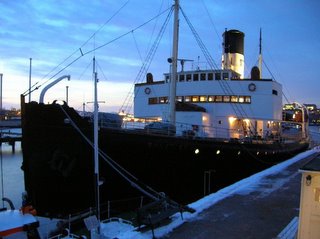
Well, that about completes our tour of the Sankt Erik—and that is a good thing because I have so much more to show all of you!
 Sankt Erik breaking ice in 1976.
Sankt Erik breaking ice in 1976.
Regelskeppet Vasa
(The Royal Ship Vasa)
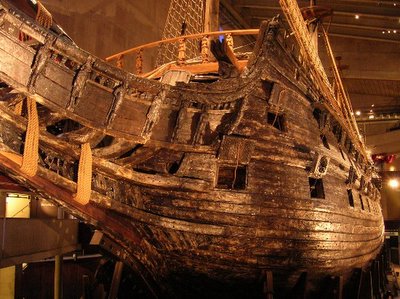
For those of you who’ve never seen the majesty of the Vasa, look now. The preservation of this ship during her 333 years on the harbor bottom is utterly astounding. She is a ghostship from the past, resurrected to stand before us in all—well, half—her former grandeur. There are not words for this ship, for seeing her standing here with her massive bulk and towering décor. There is an impenetrable solidness in her construction that seems as if it would repel any shot the Danes could have fired at her, yet in her rapidly ascending stern, she has a delicate elegance that only befits ships of fantasy. Her design is so utterly out of this world, from a time so far in our past that she seems unreal, that she could not possibly have been intended for war, and quite rightly that she could not possibly have floated and sailed.
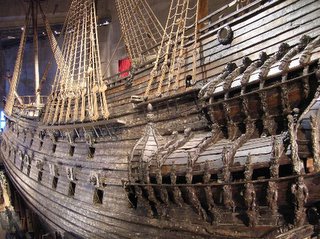
Not only do words fail to grasp the visage of the Vasa, but so do photographs. It is impossible to do her justice without coming and paying tribute to her in person. Her size for her era is stunning, her ornate decoration breathtaking, and her overall strident form simply stupefying.


A hapless-fisherman’s-eye view of the indomitable Vasa’s prow—bulbous and un-streamlined— but solid and formidably strong. The light in her gunports indicates that the conservators are onboard today, checking over the carefully marked areas where they are conducting treatment experiments on the destructive sulphur outbreaks.

Two of hundreds of wooden blocks (pulleys) found around the wrecksite—all beautifully preserved and many containing samples of Vasa’s ropes in their shivs. Speaking with Ole Magnus (a Danish man who is the world’s expert in handmade rope and is currently onboard the Sankt Erik with me) I learned that samples of virtually every gauge of rope used on the Vasa has survived. Ole is currently sorting through the dozens of 2 meter sections of Vasa’s anchor line.
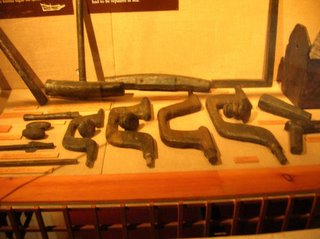
This is the remarkably preserved remains of the carpenter's tool chest.
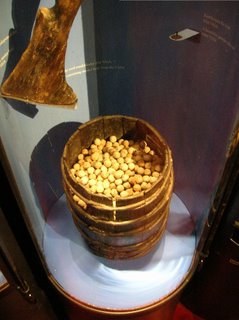
This is one of dozens of casks filled with lead musket shot. Vasa was sailing to war.
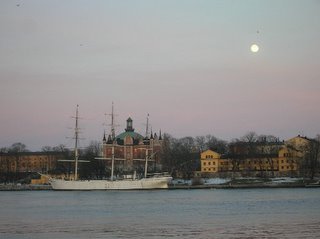 An old steel-hulled square-rigger tied up at the island of Skeppsholmen in central Stockholm. She is a youth hostel now.
An old steel-hulled square-rigger tied up at the island of Skeppsholmen in central Stockholm. She is a youth hostel now.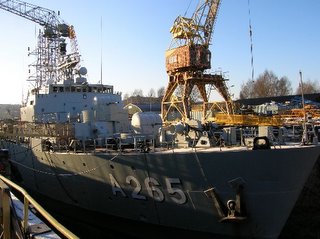 This is the graving dock (drydock built into the land. The gates are closed and the water pumped out) where Vasa was first hauled out in 1961. She floated in here on her own, being nudged along by a few tugs. Today the shipyard is still hosting the Swedish Navy.
This is the graving dock (drydock built into the land. The gates are closed and the water pumped out) where Vasa was first hauled out in 1961. She floated in here on her own, being nudged along by a few tugs. Today the shipyard is still hosting the Swedish Navy.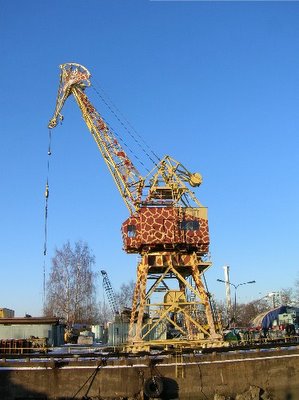 The yard crew evidently has a sense of humor as they have two of these ‘giraffe’ cranes on site.
The yard crew evidently has a sense of humor as they have two of these ‘giraffe’ cranes on site.
'Okej', I had to put this in. This is a bicycle some fool left under a downspout where melting snow poured on to his bike and then froze again. It was pretty cool.
Well, I should stop there. It is time for me to go to my office and continue with redesigning the “Skepp I strid” (Ship in battle) exhibit. I am sure I will have more photos of interest for you later. But for now,
fair winds & hejdå,
-Nat

1 Comments:
karen millen uk, ugg,uggs,uggs canada, ugg,ugg australia,ugg italia, pandora uk, canada goose, swarovski, louis vuitton, canada goose, nike air max, moncler uk, juicy couture outlet, moncler outlet, canada goose outlet, moncler outlet, canada goose, lancel, thomas sabo, pandora jewelry, gucci, louis vuitton, barbour, converse, moncler, moncler, replica watches, pandora jewelry, pandora charms, vans, montre pas cher, ugg uk, doke gabbana, supra shoes, hollister, canada goose outlet, louis vuitton, ray ban, ugg, links of london, converse outlet, coach outlet, canada goose uk, moncler, moncler, juicy couture outlet, canada goose outlet, louis vuitton, louis vuitton, toms shoes, canada goose jackets, barbour uk, marc jacobs, swarovski crystal,
Post a Comment
<< Home